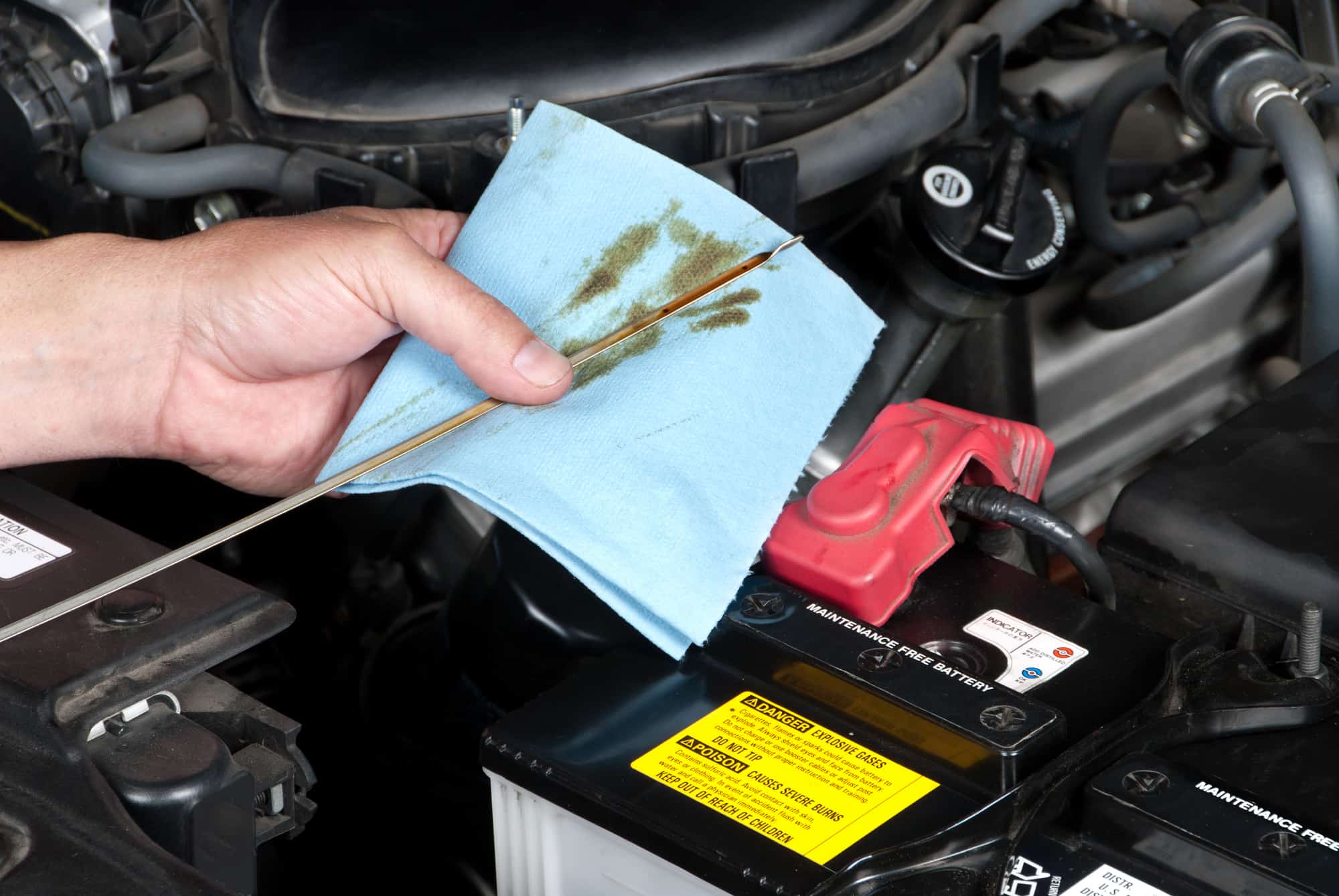The most common cause of coolant leak into engine oil is a blown head gasket. When the head gasket fails, coolant can leak into the oil passages, causing the oil to become contaminated. Other possible causes of coolant leak into engine oil include a cracked cylinder head, a damaged engine block, or a damaged oil cooler.
Coolant mixed with oil in an engine will have a milky or foamy appearance. This is due to the fact that oil and coolant have different viscosities, and when they mix, they can create a frothy or milky substance.
The milky appearance is caused by the emulsification of the oil and coolant, which can occur when the engine is running and the two fluids are agitated.
5 Common Reasons Why Coolant Leaks into Engine Oil
When coolant leaks into engine oil, it can cause serious damage to the engine and reduce its lifespan considerably.
There are several reasons why this can happen, including:
1. A Blown Cylinder Head Gasket
A blown cylinder head gasket can cause coolant to leak into the engine oil. The cylinder head gasket is responsible for sealing the engine’s combustion chambers and preventing coolant from leaking into the engine’s cylinders.
If the head gasket is damaged or blown, it can allow coolant to leak into the engine’s combustion chamber, where it is burned and expelled through the exhaust system. This can cause a loss of coolant without any visible external leaks.
A leaking cylinder head gasket can also allow coolant to leak into the engine oil passages. The cylinder head gasket sits between the engine block and the cylinder head and seals the coolant passages from the oil passages.
2. A Cracked Engine Block
A cracked engine block can cause coolant to leak into the engine oil. The engine block is responsible for housing the engine’s cylinders, coolant passages, and oil passages. If the engine block is cracked, it can allow coolant to leak into the engine’s oil passages, which can cause the oil to become contaminated with coolant.
A damaged engine block can also allow coolant to leak into the engine’s combustion chambers, where it will burn up and be expelled through the exhaust system. This can cause a loss of coolant without any visible external leaks that can lead to engine overheating.
3. A Damaged Cylinder Head
A damaged cylinder head can also cause coolant to leak into the engine oil. The cylinder head is responsible for sealing the engine’s combustion chambers and preventing coolant from leaking into the engine’s cylinders.
If the cylinder head is warped or damaged, it will no longer form a proper seal with the engine block and this can allow coolant to leak into the engine’s combustion chambers, where it is burned and expelled through the exhaust system.
The cylinder head sits on top of the engine block and contains the valves, camshaft, and other engine components. If the cylinder head is damaged, coolant can leak into the oil passages, which can cause the oil to become contaminated with coolant. This can cause a drop in engine oil pressure and a reduction in its ability to lubricate the engine.
4. A Failed Oil Cooler
A failed oil cooler can cause coolant to leak into the engine oil.
The oil cooler works by circulating engine oil through a series of small tubes or fins, which are designed to increase the surface area of the oil and allow heat to dissipate more quickly.
Some oil coolers are designed to circulate engine oil through a separate cooling system, while others are integrated into the engine’s existing cooling system. Oil coolers can be air-cooled or liquid-cooled, depending on the design of the engine and the oil cooler.
The oil cooler is typically located near the engine’s coolant system, and if it fails, it can allow coolant to leak into the oil passages. This can cause the oil to become contaminated with coolant.
5. Corroded or Damaged Cylinder Liners
Corroded or damaged cylinder liners can cause coolant to leak into the engine oil. The cylinder liners are responsible for forming the inner walls of the engine’s cylinders and providing a smooth surface for the piston to move against.
If the cylinder liners are corroded or damaged, they can allow coolant to leak into the engine’s oil passages.
Corrosion or damage to the cylinder liners can cause pitting or cavitation on the surface of the liner. This can create small holes or cavities that allow coolant to leak into the engine’s oil passages.
Over time, the coolant can mix with the engine oil, which can cause a drop in engine oil pressure and leave the oil less effective at lubricating the engine.
What Are The Symptoms of A Coolant Leak into Engine Oil?
A coolant leak into the engine oil can cause serious damage to an engine if left untreated. It can lead to a drop in engine oil pressure, engine damage, and even engine failure.
Here are some of the most common symptoms in detail:
1. Milky or Foamy Oil
When coolant leaks into the engine oil, it can create a milky or foamy substance on the oil dipstick or oil cap.
The milky or foamy appearance is caused by the emulsification of the oil and coolant, which can occur when the engine is running and the two fluids are agitated.
The milky appearance is due to the fact that oil and coolant have different viscosities, and when they mix, they can create a frothy or milky substance.This can cause a drop in engine oil pressure and engine damage.
2. Engine Overheating
If the coolant is leaking into the engine oil, it can cause the engine to overheat.
The coolant is responsible for regulating the engine temperature and preventing it from overheating. If the coolant is leaking into the engine oil, it can cause the coolant level to drop, which can lead to engine overheating and damage.
When the engine overheats, it can cause damage to the engine components, such as the cylinder head gasket or cylinder head.
Engine oil that mixes with coolant will also lose it’s ability to cool the engine. It can also cause the engine oil to break down and lose its lubricating properties, which can cause further engine damage.
3. Low Coolant Level
Another symptom of a coolant leak into engine oil is a low coolant level. This happens because the coolant is leaking into the engine oil and not staying in the cooling system where it belongs.
If coolant is leaking into the engine oil, it will almost certainly lead to engine overheating and damage.
The most common symptom of a low coolant level is a coolant level warning symbol on the dashboard, engine overheating and decreased fuel economy,
Could a Head Gasket or Valve Cover Gasket Issue Cause Coolant to Leak into the Engine Oil?
Diagnosing leaks with a head gasket is crucial to determining if coolant is leaking into the engine oil. A faulty head gasket or valve cover gasket can result in this issue, leading to potential engine damage. It’s important to address any leaks promptly to prevent further problems.
4. White Smoke From Exhaust
If you notice white smoke coming from your exhaust, it could be a sign of a coolant leak into engine oil.
When coolant leaks into the engine oil, it can also leak into the engine cylinders if the head gasket has been compromised.
This can cause the coolant to burn in the combustion chamber, which can create white smoke coming from the exhaust pipe. The white smoke is caused by the steam that is produced when the coolant is burned in the combustion chamber.
Can Water Contamination in the Gas Tank Lead to Coolant Leaking into the Engine Oil?
Water in gas tank symptoms can lead to a domino effect of issues in a vehicle. Contaminated water in the gas tank can potentially cause coolant to leak into the engine oil, leading to potential damage and mechanical issues. It’s important to address water in the gas tank symptoms promptly to avoid further damage.
5. Engine Misfires
If the coolant is leaking into the engine oil, it can cause the engine to misfire. This is because the coolant can damage the spark plugs and leave them unable to spark properly.
How to Diagnose and Fix Coolant Leak into Engine Oil
When a coolant leak into the engine oil is suspected, it is important to diagnose and fix the issue as soon as possible to prevent further damage to the engine.
The best place to start is with an OBD diagnostic readout of any error codes stored in the ECU. This issue can trigger error codes such as P0115 (Engine Coolant Temperature Circuit Malfunction), P0125 (Insufficient Coolant Temperature for Closed Loop Fuel Control), and P1281 (Engine is Cold Too Long).
If oil is leaking internally within the engine then it is not an easy problem to repair. Here are a few possible solutions that may be needed to fix the problem if the engine has not been damaged beyond repair.
1. Replace Head Gasket
One of the most common causes of coolant leaking into the engine oil is a blown head gasket. Symptoms of a blown head gasket include white smoke coming from the exhaust pipe, overheating, and loss of power.
To replace the head gasket, the engine head must be removed and the old gasket scraped off. The new gasket is then installed and the engine head is reattached.
2. Repair the Engine Block
If the engine block is cracked, it will need to be repaired or replaced. Symptoms of a cracked engine block include coolant leaking into the engine oil, overheating, and loss of power.
To repair the engine block, it must be removed from the vehicle and taken to a machine shop for repair. If the damage is too severe, the engine block may need to be replaced.
3. Replace the Cylinder Head
If the cylinder head is cracked, it will need to be replaced. Symptoms of a cracked cylinder head include coolant leaking into the engine oil, overheating, and loss of power.
To replace the cylinder head, the engine head must be removed and the old cylinder head removed. The new cylinder head is then installed and the engine head is reattached.
4. Flush the Engine
After the coolant leak into the engine oil has been fixed, it is important to flush the engine to remove any remaining coolant from the oil system. This can be done by draining the oil and replacing it with fresh oil.
The engine should then be started and run for a few minutes before the oil is drained again. This process should be repeated until the oil is clear and free of coolant.











I recently noticed a milky substance on my oil dipstick. Could this be a sign of coolant leaking into my engine oil, and if so, what immediate steps should I take to address this issue?
I’ve noticed a milky substance on my oil dipstick, and my car has been overheating recently. Could this be due to a coolant leak into my engine oil, and if so, what steps should I take to diagnose and potentially fix this issue?